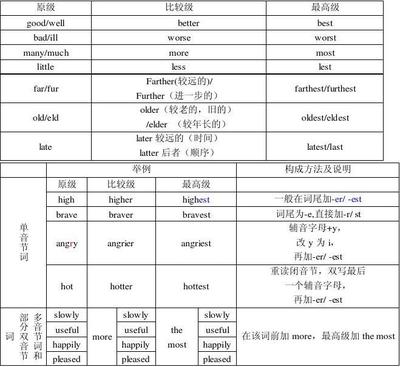一、时间副词
1. 常见的时间副词
常见的时间副词有now(现在;立刻;目前;马上;其时;当时) then(当时;那时;接着;于是;然后;还有;而且;那么;因此)soon(不久;即刻;马上;宁可;;宁愿) ago(以前)recently(最近;近来)lately(近来;最近;不久前)later(较晚地;后来)finally(最后;终于;完全地)before(先前;从前;以前)early(早;先;在初期;在早期)today(今天)tomorrow(明天)yesterday(昨天)tonight(今晚)suddenly(意外地;忽然;冷不防)immediately(即刻;马上;直接地) already(已经)just(刚刚)等。
2. 时间副词在句中的位置
(1)表确定时间的副词(如today, yesterday等)通常位于句末,有时也位于句首:
Hewent home yesterday. / Yesterday he went home. 他昨天回家了。
而那些表示非确定时间的副词(如soon,recently, suddenly等)除可用于句末或句首外,还可位于句中(通常位于实义动词之前,动词be、助动词、情态动词之后):
Hewent to Paris recently. / He recently went to Paris. / Recently hewent to Paris. 最近他去了巴黎。
(2)still, already, just 等几个表示时间的副词通常位于句中(实意动词之前,动词be、助动词、情态动词之后):
He’s just left for school. 他刚刚去学校。
Ihave already finished my work. 我已经做完了工作。
当要表示强调时,still和already也可位于动词be、助动词等之前:
She was still [still was] beautiful at the age offorty. 她到了40岁仍然很美。
Ialready have told him about it. 我已经把情况告诉他了。
still若用于否定句,则总是位于助动词之前:
Istill don’t understand what you mean. 我还是不明白你的意思。
另外,still 和already 还可位于句末,表示惊奇:
Are you on page one still? 你还在看第1页?
Isyour mother back already? 你妈妈就已经回来了?
二、地点副词
1. 常见的地点副词
常见的地点副词有here(在这里;向这里;到这里;这是;现在;在这一点上)there(在那里;往那里;那里;那个;在那一点上;关于那一点)up(成直立姿势;起床;向上;向北;在北部;完全地;彻底地)down(向下;在下面;往南)away(远处;离开)nearby(附近地)home(家)ahead(在某人或某事物的前面)abroad(离口侧;对口侧)indoors(在室内;往室内)overseas(在[向]海外;在[向]国外)halfway(半途;中间)upstairs(在楼上;往楼上)downstairs(在楼下)等。
2. 地点副词在句中的位置
地点副词在句中通常位于句末或句首,但从不位于主语和谓语之间。若有多个副词排列,地点副词通常位于方式副词之后,时间副词之前:
Can you help to carry this table upstairs?你能帮忙把桌子搬到楼上去吗?
The boy read quietly over there all afternoon.这男孩整个下午都在那儿静静地看书。
三、方式副词
1. 方式副词的特点
方式副词表示动词的行为方式,许多以-ly结构的副词都是方式副词,如carefully(仔细地;周密地;警惕地)happily(快乐;满意;幸运;幸好)quietly(轻声地;安静地;静止地;寂静地;在暗中;秘密地;不张扬地)heavily(严重地;大量地)warmly(温暖地;亲切地;热烈地;热情地;热心地)correctly(正确地;得体地)politely(有礼貌地;客气地;委婉地)angrily(愤怒地;生气地)等。
2. 方式副词在句中的位置
(1)方式副词通常位于动词(及其宾语)之后:
Heread the letter slowly. 他从容不迫地看了那封信。
方式副词通常不位于动词与宾语之间,除非动词后的宾语很长:
不可说:We like very much it. (应改为We like it very much.)
但可说:We could see very clearly a strange light ahead ofus. 我们可以很清楚地看到在我们前方有一道奇怪的光。
若遇到“动词+介词+宾语”结构,方式副词既可位于“介词+宾语”之前,也可位于“介词+宾语”之后,但是若该结构的宾语较长,则方式副词通常位于“介词+宾语”之前:
Helooked at me curiously. / He looked curiously at me.他好奇地打量着我。
Helooked curiously at everyone who got off the plane.他好奇地打量着从飞机上走下来的每一个人。
(2)方式副词(主要是单个的方式副词)有时也可位于主语与动词之间:
Hequickly got dressed. 他赶紧穿好衣服。
Heangrily tore up the letter. 他很生气,把信撕碎了。
(3)有的方式副词(如bravely, cleverly, cruelly,foolishly, generously, kindly, secretly, simply等)位于动词之前和位于句末会导致句子意思的变化:
They secretly decided to leave the town.他们秘密决定离开这个城市。
They decided to leave the town secretly.他们决定秘密地离开这个城市。
Heanswered the questions foolishly. 他对这个问题作了愚蠢的回答。
Hefoolishly answered the questions. 他愚蠢地回答了这个问题。
(4)有的方式副词(如gently, quietly, slowly,suddenly 等)有时可位于句首,以达到某种戏剧性的效果(这主要见于书面语中):
Suddenly, the driver started the engine.突然地,司机启动了发动机。
四、频度副词
1. 频度副词的特点
频度副词表示动作发生的次数,常见的有(a)always(总是;永远),continually(不停地;持续地)frequently(频繁地),occasionally(偶尔),often(经常),once(一次;曾经),twice(两次;两倍),periodically,repeatedly(重复地;再三地),sometimes(有时候),usually(通常)等(b)ever(在任何时候;在某时;有时;从来),hardly ever(几乎从不;很少),never(从不;永不;从来没有),rarely(不常;很少地),scarcely ever(仅仅;几乎不),seldom(很少)等
我们可将频率副词按频率从高到低的排列顺序,用百分率表示为:
always=at all times表示“总是,永远”之意,相当于100%的频率。
usually=in most cases表示“通常,惯常”之意,相当于90%的频率。
often=manytimes表示“多次,经常”之意,相当于80%的频率。
sometimes=at sometimes but not all the time表示“有时候,偶尔”之意,相当于30%的频率。
hardly(ever)=almost never或very seldom表示“很少,几乎从不”之意,相当于百分之几。
never=at no time或not ever表示“永不,从未”之意,相当于0%的频率。
这里的百分数只是为了便于区分它们所表示频率的程度而已,不能完全按这些百分率去理解。
另外,表示频率还可用一些副词短语来表示,如once a week一周一次,three times a year一年三次等。
2. 频度副词在句中的位置
(1)频度副词通常位于实义动词之前, be动词、助动词、情态动词之后,如果有两个助动词,频度副词通常放在第一个助动词后面:
Heoften comes to see us. 他常来看我们。
Heis seldom late for school. 他上学很少迟到。
Wehave never been invited to one of their parties.
有时为了强调,频度副词也可位于be动词、助动词等之前, 此时助动词等应重读。如:
She always was late. 她老是迟到。
(2)在简略答语中,当频度副词与be动词、助动词或情态动词位于句末时,频度副词必须前置。如:
“Philip is late again.” “Yes, he always is.”
“菲利普又迟到了。”“是的,他总是迟到。”
“Can you park your car near the shops?” “Yes. I usuallycan.”
“你可以在商店附近停车吗?”“是的,通常可以。”
Iknow I should take exercise, but I never do.
他们聚会,一次也没邀请过我们。
She must sometimes have wanted to run away.
她有时候一定想到过要逃走。
(3)haveto 表示客观需要的"不得不"时,虽相当于情态动词,但频度副词要放在它之前。例如:
Ioften have to get up at five. 我经常得五点钟起床。
当句子中有used to 这个"临界性情态动词"时,频度副词既可以在其前也可以在其后。例如:
Wealways used to go to the seaside in May.
Weused to always go to the seaside in May.
那时候,我们总是五月份到海滨去。
(4)有的频度副词(如sometimes, often, usually,frequently, occasionally等)可位于句首(此时多半是因为强调或对比)。
Sometimes he went there by bus. 有时他坐公共汽车去那儿。
Very often the phone rings when I’m in the bath.电话经常在我洗澡时响。
另外,频度副词always 和 never通常不位于句首,除非是祈使句:
Always remember this. 时刻记住这一点。
Never go out at night. 晚上千万不要出去。
often用于句首时,通常表示强调,且其前一般有quite, very修饰。如:
Very often he comes in late. 他常常迟到。
Quite often the phone rings when I’m in the bath.电话经常在我洗澡时响。
usually有时也用于句首,其前不用修饰语。如:
Usually I get up early. 我平时起得早。
(5)有的频度副词可位于句末,但通常会带有very, only等修饰语。
Wego out very seldom. 我们很少外出。
Doyou go to the cinema very often? 你常去看电影吗?
usually有时也用于句末,其前不用修饰语。如:
I’m not late, usually. 我通常不迟到。
Iget paid on Fridays usually. 我通常在星期五领工资
注:有时也可不带修饰语,但主要见于否定句或疑问句。如:
Doyou come here often? 你常来这儿吗?
Idon’t come here often. 我不常来这儿。
sometimes常可用于句末。
Weall get into trouble sometimes.
我们有时都会遇到麻烦。
ever可与否定动词连用,特别是在与复合时态连用时,可代替never+肯定动词。
【注】含有否定意义的频度副词置于句首时,其后要用倒装语序:
Never have I been there. 我从未去过那儿。
Seldom does he see a film. 他很少看电影。
另外,频度副词always 和 never通常不位于句首,除非是祈使句:
Always remember this. 时刻记住这一点。
Never go out at night. 晚上千万不要出去。
3. 频度副词在否定句中的位置
在否定句中,有的频度副词却必须要位于否定词not之前(如sometimes,frequently);有的频度副词则必须位于否定词之后(如always, constantly, continually,continuously,均含有“连续不断”之意),;有的频度副词可位于否定词not之后或之前(如usually, often):
Hedoesn’t usually come here. / He usually doesn’t come here.他通常不来这儿。
She doesn’t always come late. 她并非总是迟到。(不能说always doesn’t)
Heis sometimes not responsible for what he does. 他有时对所做的事不负责任。
1.频度副词usually和often可位于否定词not之前或之后。如
他们不常开这样的晚会。
正:They don’t often hold such parties.
正:They often don’t hold such parties.
星期日我们一般不在9点以前起床。
正:We don’t usually get up before nineon Sundays.
正:We usually don’t get up before nine on Sundays.
在否定句中,频度副词用于句中或句首,有时会导致意思不同。如:
Hedoesn’t usually sleep for two days at a time.
他很少一连睡两天。
Usually he doesn’t sleep for two days at a time.
他连续两天不睡觉是常事。
2. 频度副词always总是位于否定词之后,不可位于否定句之前。如:
Things are not always what they seem to be.
外表往往是靠不住的。
Silence must not always be read as consent.
沉默并不见得一定意味着同意。
3. 频度副词sometimes总是位于否定词之前,不可位于否定词之后。如:
Jim is sometimes not very punctual.
吉姆有时不太准时。
Debbie is sometimes not responsible for what shedoes.
戴比有时对她所做的事不负责任。
五、程度副词
1. 程度副词的特点
程度副词用于表示程度,常见的有 fairly(公平地;诚实地), pretty(相当), rather(在一定的程度上;相当), quite(完全地;整体地;十分地;同意;不错;对的), very(完全;非常;十分;极), much(十分;差不多;几乎), too(太;再), greatly(大大地;非常), almost(几乎;差不多;差一点;将近), nearly(几乎;差不多), half(一半), highly(高度地;极;非常;非常赞许地), awfully(<口>恶劣地;令人嫌恶地<古>令人畏惧地), deeply(在深处;到深处;强烈地;深刻地;精心地;巧妙地), partly(部分地;不完全地;在一定的程度上), perfectly(完美地;理想地;完全地;十足地), really(真正地;确实地;实际地;很;十分;全然)等。
2. 程度副词的用法注意点
(1)程度副词主要用于修饰形容词和副词,有的还可修饰比较级(如much, rather 等)和最高级(如quite, much, almost等):
Houses are much more expensive these days.如今的房价贵多了。
This is quite [much] the most expensive radio here.这是这里最贵的收音机。
【注】quite 有时也修饰比较级,但只用于quite better(身体康复)这一表达。
(2)有的程度副词(如almost,barely,enough,hardly,just,(a)little,much,nearly,quite,rather,really和scarcely。除了much以外,其他的都可位于主要动词之前,与频度副词的用法相同)可修饰动词,但有的(如fairly, pretty,very等)则不能修饰动词:
Iquite agree with you. 我完全同意你的意见。(不用fairly, pretty, very)
Werather like the film. 我们很喜欢这部电影。(不用fairly, pretty, very)
(3)个别的程度副词(主要是quite和rather)还可修饰名词(注意词序):
It’s quite [rather] a good idea. / It’s a quite [rather]good idea. 那可真是个好主意。
若此结构中没有形容词,则 quite 和 rather 则只能放在冠词之前:
Itwas quite [rather] a success. 那事相当成功。
3. 程度副词在句中的位置
1.程度副词用在实义动词前,Be动词、助动词、情态动词之后。
Ialmost forgot to bring my key.
我差点忘记带钥匙。
I could hardly believe it.
我几乎不能相信它。
2.程度副词用在形容词或副词前,enough除外。
He drives very carefully.
他驾驶很小心。
He is old enough to go to school.
他够年龄,可以上学了。
3.程度副词much(…得多),even(更加)可在形容词或副词的比较级之前作修饰语。
This question is much more difficult than thatone.
这个问题比那个问题难多了。
Canada is even larger than the UnitedStates.
加拿大甚至比美国还大。
only也可以修饰动词,从理论上讲它应紧挨所修饰的词,位于动词、形容词、副词之前,位于名词、代词之前或之后:
六、连接副词
1. 连接副词的分类
连接副词可分为两类,一类是用于连接句子或从句,常见的有therefore(因此;为此;所以), besides(而且;还有), however,moreover(此外;而且), still(仍然;依旧;还是), thus(如此;这样), meanwhile(同时;其间)等;另一类是用于引导从句或不定式,主要的有when(什么时候), why(为什么), where(在哪里), how(怎么样)等。
2. 连接句子或从句的连接副词
其性质类似于并列连词,使用时其前通常用分号或句号;若其前用逗号,则通常带有并列连词(如and):
Idon’t like it; besides, it’s too expensive. 我不喜欢它,而且也太贵了。
Weall tried our best; however, we lost the game. / We all tried ourbest. However, we lost the game. 我们都已尽了最大的努力,不过我们还是输了。
注意,有的连接副词(如however等)后通常有逗号与句子的其他成分隔开。另外,这类副词有的还可位于句中或句末:
Hemay, however, come later. 不过,他也许一会儿就到。
Weall tried out best. We lost the game, however. 我们都已尽了最大的努力,不过我们还是输了。
Peter is our youngest child, and we have three othersbesides. 彼特是我们最小的孩子,我们另外还有三个。
3. 引导从句和不定式的连接副词
用于引导从句(名词性从句)或不定式的连接副词主要有when, why, where,how等:
Tell me when we shall leave. / Tell me when toleave. 告诉我什么时候离开。
Idon’t know how I can find him. / I don’t know how to findhim. 我不知道如何找到他。
Where we can get the money is just our problem. / Where toget the money is just our problem. 到哪里去弄这笔钱正是我们头痛的事。
That’s why he speaks English so well. 那就是他为什么英语讲得这么好的原因。
【注】连接副词why 后不能接不定式,如可说 I don’t know why I must leave.(我不知道我为什么必须离开),但不能说Idon’t know why to leave。
七、关系副词
1. 关系副词的特点
关系副词用于引出定语从句,主要有when(什么时候), where(在哪里), why(为什么):
Sunday is the day when very few people go to work.星期日是没什么人上班的日子。
That’s the reason why he dislikes me. 这就是他不喜欢我的原因。
Doyou know a shop where I can find sandals? 你知道哪家商店我能找到凉鞋吗?
【注】关系副词用于引出定语从句,且在从句中用作状语。关系副词when表示时间,where表示地点,why表示原因。
2. 使用关系副词的注意点
(1)how 不能用作关系副词,不要想当然地将how用作关系副词置于the way 后表示方式:
他说话就是那个样子。
误:This is the way how he spoke.
正:This is how he spoke. / This is the way (that, in which) hespoke.
(2)关系副词when和where既可引导限制性定语从句,也可引导非限制性定语从句,但why只能引导限制性定语从句,不能引导非限制性定语从句(若引导非限制性定语从句,可用for which reason)。
(3)引导定语从句时,when 的先行词为时间,where的先行词为地点,why的先行词为原因(主要是the reason),但是反过来却不一定:
Don’t forget the time (that) I’ve told you.不要忘记我告诉你的时间。
This is the house (that) he bought recently.这就是他最近买的那座房子。
Please tell me the reason (that) you know.请告诉我你所知道的原因吧。
八、疑问副词
1. 疑问副词的特点
疑问副词有when(什么时间), where(在那里), why(为什么), how(怎么样)等,用于引出特殊疑问句:
Where do you come from? 你是哪里人?
When will it be ready? 这什么时候能准备好?
Why was she crying? 她刚才为什么哭?
2. 两类易混句型的区别。请看以下两句:
Where do you think he has gone? 你认为他去什么地方了?
Doyou know when he will come? 你知道他什么时候来吗?
上面第一句为特殊疑问句,第二句为一般疑问句,它们不能倒过来说成Do you thinkwhere he has gone? When do you know he will come?其区别是:可以用 yes 或 no 回答者,用一般疑问句的形式(疑问词放在句中,即主句之后),适合这类句型的主句动词通常有know,hear, ask, tell 等;不能用 yes 或 no 回答者,用特殊疑问句的形式(疑问词放在句首),适合这类句型的主句动词通常有think, believe, suppose, guess 等。
3. 使用疑问副词的注意点
(1)疑问副词用于引导特殊疑问句,通常位于句首,但有时也不一定:
Without friends where are we? 没有朋友我们会怎样?
(2)疑问副词引导特殊疑问句时,其后应接一般疑问句,但有时可有所省略:
Why argue with him? 为什么要与跟他争吵?
Why not ask the teacher? / Why don’t you ask theteacher? 为什么不问问老师呢?
【注】Why 或Why not后接动词原形,不接带to不定式,主要用于现在或将来,不用于过去,如不说whynot tell me yesterday?应改为Why didn’t you tell meyesterday?(昨天为什么不告诉我?)
(3)有时两个疑问副词连用:
When and where were you born? 你生于何时何地?
九、句子副词
1. 句子副词的特点
句子副词用于修饰句子(而不是修饰某个单词),反映说话人的观点和看法,如actually(实际上;实在地;确实), certainly(无疑地;确定地), clearly(明亮地;明净地;明确地;清楚地;显然地;无疑地), definitely(明确地;确切地;一定地;肯定地), evidently(明显地;显然地), fortunately(幸运地;幸亏), frankly(坦诚地), honestly(诚实地;正直地;坦诚地;实在地), luckily(幸运地), obviously(显然地;明白地), perhaps(或许;大概;可能), possibly(可能地;也许;或许), probably(或许;大概;可能), surely(想必;谅必;稳当地;确实地;踏实地), undoubtedly(的确地), unexpectedly(未料到地;意外地)等。
2. 句子副词在句中的位置
句子副词通常位于句首(或分句句首):
Obviously he can’t tell the difference between them.显然他无法区别两者的不同。
Iarrived late but luckily the meeting had been delayed.我迟到了,幸而会议推迟了。
但有些句子副词也可以出现在句中:
Hesmiled nastily. He evidently knew something I didn’t.他发出狞笑,他显然知道一些我所不知道的事。
有的句子副词也可用作其他种类的副词,不过这往往会导致位置和语义的变化:
Clearly he didn’t say so. 显然他没有这样说。(句子副词)
Hedidn’t say so clearly. 他说得没有那么清楚。(方式副词)
Frankly, you are wrong. 说实在的,你错了。(句子副词)
Hespoke frankly about his past life. 他坦率地谈了他过去的生活。(方式副词)
十、焦点副词
1、焦点副词的概念
所谓焦点副词就是指对所修饰的词进行强调,使之成为人们注意的焦点的副词。这类副词常见的only(只有;才), alone(单独地;独自地), also(也;同样;并且), even(甚至;即使)just(正好;恰好), merely(仅仅;只不过), really(真正地;踏实地;实际上), simply(简单地;简易地;朴素地;仅仅;只不过<非正>实在;简直;非常), mainly(大部分地;主要地), chiefly(主要地;首要地;尤其), especially(尤其;特别), exactly(精确地;准确地;确切地)等。
2、焦点副词的位置与用法
(1)焦点副词通常位于它所修饰的词语之前。如:
Even a child can do it. 即使是小孩也会做。
This school is mainly for boys. 这所学校主要招收男生。
【说明】alone 总是位于所修饰的词之后。如:
Tom alone can do the work. 只有汤姆能做这工作。
比较:
Tom alone is coming. 只有汤姆要来。(alone 为焦点副词)
Tom is coming alone. 汤姆将一个人来。(alone 为方式副词)
(2)焦点副词在句中的位置不同可能会导致句子意思的变化。如:
Only I kissed her last night. 昨晚只有我吻了她(即别人没吻她)。
Ionly kissed her last night. 昨晚我只是吻了她(即没干别的事)。
Ikissed only her last night. 昨晚我吻的只有她(即没吻过别人)。(from www.nmet168.com)
Ikissed her only last night [last night only]. 我只是在昨晚才吻了她(即其他时候未吻过)。
副词的排列顺序
1.副词的排列顺序是指在一个句子中有多个副词时,一般要按情状副词、地方副词、频率副词、时间副词的顺序排列。
The man runs slowly along the river at six o'clock everymorning.
这个人每天早上六点钟慢慢地沿着河边跑步。
I'm used to getting up early at sixo'clock every morning.
我习惯每天早上六点钟早早起床。
几个副词一起使用时,一般的词序是:程度---(状态)----地点----时间
The girl played the piano fairly well here lastnight.
程度+地点+方式+时间副词
2.在句子中若有多个时间副词,要从短时间到长时间排列, 小单位的在前,大单位在后。
Hewoke up at six in the morning on the fifth of October.
他在 十月五日早上六点醒来。
Ibroke my legs in the evening on the fifth of October lastyear.
去年十月五日的晚上我摔断了双腿。
3.在句子中若有多个地方副词,要从小地方到大地方排列。
Imet him at a bar in a small town in New York State.
我在纽约州的一座小镇的酒吧里遇到了他。
Imet a beggar at the gate of a park in a small town in London oneday.
一天我在伦敦一座小镇的公园门口遇到一个乞丐。
4)方式副词,短的在前,长的在后,并用and或but等连词连接。
Please write slowly and carefully.
Each year many tourists come to Xi’an from all corners of theworld.(具体/小的在前,笼统/大的在后)
She worked slowly and carefully.(短的在前,长的在后,其间用and或but连接)
情状副词
1.情状副词表示状态,性质或方式,一般由形容词+ly构成,如:slow-slowly。
2.情状副词用在不及物动词后。
Heruns fast.
他跑得快。
3.情状副词用在不及物动词与介词之间或句尾。
中文:他慢慢地与外国人说话。
(误)He spoke to slowly theforeigner.
(正)He spoke slowly to theforeigner.
(正)He spoke to the foreignerslowly.
4.情状副词用在及物动词前或句尾。
中文:他静静地离开了房间。
(误)He left quietly the room.
(正)He quietly left the room.
(正)He left the room quietly.
5.情状副词用在所修饰的形容词或副词前。
It is really important.
这真的重要。
The tree grows wonderfully fast.
这树长得快得惊人。
6.情状副词用在BE与分词之间或句尾。
中文:他正在大声读报。
(误)He is reading loudly thenewspaper.
(正)He is loudly reading thenewspaper.
(正)He is reading the newspaperloudly.
7.情状副词在句首,加强语气。【参见叙述形容词】
Quickly I picked up the gun.
我迅速拿起枪。
情状副词是指用来说明情况,状况或性质的副词
情状副词句型:
1. S + V + 情状副词
2. S + V + O + 情状副词 = S + 情状副词 + V + O
3. S + be动词+V-ing +情状副词= S +be动词+情状副词+V-ing
4. S + V + 介系词 + O +情状副词= S+情状副词+ V+ 介系词 + O
= S + V + 情状副词 + 介系词 + O
5. S + V + O +副词+ 地方副词 = S + V + O + 地方副词 + 副词
= S + 副词 + V + O + 地方副词 = 副词 + S + V + O + 地方副词
情状副词: adj + ly
(1) 字尾是 子音 + y ---- 去掉y, 改为 ily
ex: happy ---- happily, lucky ---- luckily
(2) 字尾是 le ---- 去掉 e + y
ex: terrible ---- terribly, comfortable ---- comfortably
(3) 字尾是 ll ----只+ y:ex: full ---- fully
(4) 形容词和情状副词同形: ex: early, late, fast, hard
(5) 不规则变化: good ---- well
范例
他们快乐地玩著
They play happily.
他快乐地做这份工作:
He does the work happily. = He happily does thework.
他们正慢慢地跑著:
They are running slowly. = They are slowly running.
他快速地走进叫室: He walked into the classroomslowly.
= He slowly walked into the classroom.
= He walked slowly into the classroom.
马克快乐地在房间唱歌:
Mark sang an English song in his room happily.
= Mark happily sang an English song in his room.
= Mark happily sang an English song in his room.
= Happily Mark sang an English song in hisroom
她教书教得好: She teaches well.
 爱华网
爱华网



